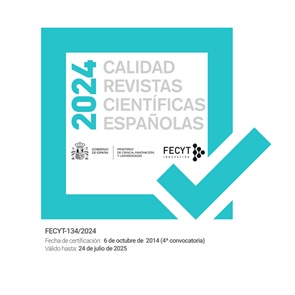Perspectivismo con objetividad, causal y temporal
Resumen
It has been suggested that the only plausible way to integrate causality in the scientific image of the world is through a subjectivist causal perspectivism. Causation would exist only from the point of view of an agent capable of doing things. The conception of time associated with such causal perspectivism is certain temporal perspectivism that is also subjectivist. Following some ideas of Ramsey, Huw Price is a recent exponent of these approaches, which are rooted in Russell's critique of the notion of causality and in McTaggart’s irrealism about time. We analyze this line of thought and argue for an objectivist interpretation of those perspectivisms. It will be crucial a distinction between perspectives and the subjects capable of adopting them, as well as an analysis of the conditions for adopting perspectives.
Descargas
-
Resumen822
-
pdf 565
Citas
Álvarez, S. (2014), “Causation and the agent’s point of view”, Theoria, vol. 29, nº 79, 133-147.
Álvarez, S. (2015), “Kinds, Laws and Perspectives”, in: Vázquez and Liz (eds.) (2015), 235-250.
Anscombe, G. (1971), Causality and Determination, Cambridge: Cambridge Univ. Press [Reprinted in: The Collected Philosophical Papers of G. E. M. Anscombe, Minneapolis: Univ. of Minnesota Press, vol. 2].
Cartwright, N. (1979), “Causal Laws and Effective Strategies”, Nous 13. 419-37.
Dummett, M. (1954), “Can an Effect Precede its Cause?”, Proceedings of the Aristotelian Society Supplementary Volume 38, 27-44.
Dummett, M. (1964), “Bringing about the Past”, Philosophical Review 73, 338-59.
Field, H. (2003), “Causation in a Physical World”, in: M. Loux and D. Zimmerman (eds.): Oxford Handbook of Metaphysics, Oxford: Oxford Univ. Press, 435-60.
Hales, S. (2015), “Synchronic and Diachronic Luck”, in: Vázquez and Liz (eds.) (2015), 255-263.
Hautamäki, A. (2015), “Change, event, and Temporal Points of View”, in: Vázquez and Liz (eds.) (2015), 197-221.
Lewis, D. (1979), “Counterfactual Dependence and Time’s Arrow”, Nous 13, 455-76.
Liz, M. (2015), “Flowing Time, Mind, and Points of View”, in: M. Vázquez and M. Liz (eds.) (2015).
McTaggart, J.M.E. (1908), “The unreality of time”, Mind, 17, 457-474.
McTaggart, J.M.E. (1927), The Nature of Existence, Cambridge: Cambridge Univ. Press
Mellor, D. (1981), Real Time, Cambridge: Cambridge Univ. Press.
Mellor, D. (1998), Real Time II, London: Routledge.
Price, H. (2014), “Where would we be without counterfactuals?”, in: M. Galavotti et al. (eds.): New Directions in the Philosophy of Science, Heidelberg: Springer, 589-607.
Rabinowicz, W. (2002), “Does Practical Deliberation Crowd Out Self-prediction?” Erkenntnis 57, 91-122.
Ramsey, F. (1929), “General Propositions and Causality”, in: D. Mellor (ed.): Foundations: Essays in Philosophy, Logic, Mathematics and Economics, London: Routledge and Kegan Paul, 1978, 133-51.
Russell, B. (1913), “On the Notion of Cause”, Proceedings of the Aristotelian Society. New Series 13, 1-26.
Vázquez, M. (2013), “El cable del tiempo”, in: Liz, M. (ed.): Puntos de vista. Una investigación filosófica, Barcelona: Laertes, 249-262.
Vázquez, M. (2015), “Branching Time Structures and Points of View”, in: Vázquez and Liz (eds.) (2015), 185-195.
Vázquez, M. and M. Liz (eds.) (2015), Temporal Points of View. Subjective and Objective Aspects, Heidelberg: Springer.
Las obras que se publican en esta revista están sujetas a los siguientes términos:
1. El Servicio de Publicaciones de la Universidad de Murcia (la editorial) conserva los derechos patrimoniales (copyright) de las obras publicadas, y favorece y permite la reutilización de las mismas bajo la licencia de uso indicada en el punto 2.
2. Las obras se publican en la edición electrónica de la revista bajo una licencia Creative Commons Reconocimiento-NoComercial-SinObraDerivada 3.0 España (texto legal). Se pueden copiar, usar, difundir, transmitir y exponer públicamente, siempre que: i) se cite la autoría y la fuente original de su publicación (revista, editorial y URL de la obra); ii) no se usen para fines comerciales; iii) si remezcla, transforma o crea a partir del material, no podrá distribuir el material modificado.
3. Condiciones de auto-archivo. Se permite y se anima a los autores a difundir electrónicamente las versiones pre-print (versión antes de ser evaluada) y/o post-print (versión evaluada y aceptada para su publicación) de sus obras antes de su publicación, ya que favorece su circulación y difusión más temprana y con ello un posible aumento en su citación y alcance entre la comunidad académica. Color RoMEO: verde.











